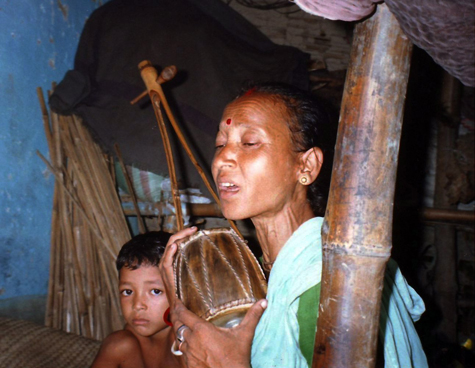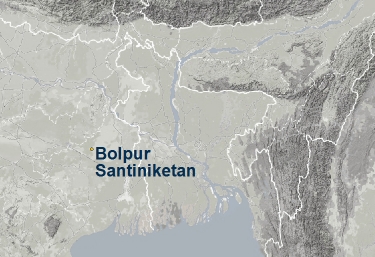Masadda, Birbhum. 24 July 2004. Kalpana Dasi
boli eke eke mile gelo
I met the Baul couple, Shyamsundar Das and his khepi or partner, Kalpana Dasi, at Bolpur station. It was Nimai Chand Baul, the dotara player and singer, who had told me about Kalpana; he said she was one of the prominent women singers among the bauls now. I was interested, because you don’t get too many women singers amongst the bauls. Kalpana and Shyamsundar were busking on a train coming from the direction of Sainthia and when it reached Bolpur, Nimai asked them to get down. He introduced us and I explained I was looking to record folk singers on the theme of biraho and they invited me to go with them to their home. We took a train back to a place called Batashpur, then a van rickshaw to Masadda, about 1.5 km from the station; Nimai Chand came along.

Kalpana Dasi
The village roads were muddy and slippery in that monsoon season; the pond at the entrance was filled to the brim with water. Then it started to rain. We had our hour-long recording session in the veranda of Kalpana Dasi and Shyamsundar Das Baul’s mud hut. I used my old Sony Walkman WM-D6C professional cassette recorder and Sennheiser E-835 microphone—although the IFA grant had come through, the field recording equipment hadn’t yet been bought.
Kalpana is the second wife of Shyamsundar, his young singing partner. She is unlike her elder co-wife, who manages home and the children, even Kalpana’s, when she goes out to sing. The two wives have separate homes. However, Kalpana’s early return from work that morning had brought her little boy running and he clung to her even while she sang songs about Radha’s love and longing for Krishna and dehotattva songs about the need to cleanse the human body and soul in order to house the divine ‘Ras er manush’. These were old poetry of Haripada Gonsai and Jadubindu as well as songs of contemporary composers like Jiban Khepa. Kalpana sang, plucking on her ektara, while Shyamsundar played the khamak or gubgubi and tapped the rhythm with his ghungur-strapped foot. Nimai’s dotara remained silent as it could not match Kalpana’s pitch. She sang in her typical Birbhum voice—voices that need to rise above the din of running trains and crowded melas in order to be heard.
The men sang too, but I was more affected by Kalpana’s songs. I was not just listening to her but also watching her, thinking how she balanced her life between the songs and her domesticity. Her situation was different from that of Nirmala Roy of Saptiguri, because what she sang was not about her everyday life. Did she then remain external to the songs, despite stretching her voice beyond its outer, upper limits? Could it be that she was more concerned with form than content, with the act of singing which gave her a space beyond domesticity and also a special place beside her husband?
The clip here is from a composition by Jadubindu.
Written in 2010.
For songs of Jadubindu see:
Chakraborty, Sudhir, Gobheer Nirjan Pathe. Kolkata: Ananda Publishers, 1989
Urban, Hugh, The Economics of Ecstasy: Tanta, Secrecy, and Power in Colonial Bengal. New York: OUP, 2001
- Saptiguri, North Bengal. 27 November 2003. Nirmala Roy
- Bolpur, Birbhum. 25 November 2003. Nimai Chand Baul
- Kolkata. 4 September 2019. Purnadas on Nabani Das Baul
- Surma News Office, Quaker Street, East London. 27 February 2007. Ahmed Moyez
- Ambikapur, Faridpur, Bangladesh. 29 April 2006. Hajera Bibi
- Sylhet, Bangladesh. 22 April 2006. Chandrabati Roy Barman and Sushoma Das
- Sylhet, Bangladesh. 21 April 2006. Arkum Shah Mazar
- Sylhet, Bangladesh. 20-21 April 2006. Ruhi Thakur and others
- Jahajpur, Purulia. 27 February 2006. Naren Hansda and others
- Faridpur, Bangladesh. 24 January 2006. Binoy Nath
- Uttar Shobharampur, Faridpur, Bangladesh. 22 January 2006. Ibrahim Boyati
- Baotipara, Faridpur, Bangladesh. 21 January 2006. Kusumbala Mondal and others
- Kumar Nodi, Faridpur, Bangladesh. 21 January 2006. Idris Majhi and Sadek Ali
- Debicharan, Rangpur, Bangladesh 18 January 2006 Anurupa Roy & Mini Roy, Shopon Das
- Mahiganj, Rangpur, Bangladesh. 17 January 2006. Biswanath Mahanta & Digen Roy
- Chitarpur, Kotshila, Purulia. 28 November 2005. Musurabala
- Krishnai, Goalpara, Assam. 30 August 2005. Rahima Kolita
- Chandrapur,Cachar. 28 August 2005. Janmashtami
- Silchar, 25 August 2005, Barindra Das
- Kenduli,Birbhum. 14 January 2005. Fulmala Dasi
- Kenduli, Birbhum. 13 January 2005. Ashalata Mandal
- Shaspur, Birbhum. 8 January 2005. Golam Shah and sons Salam and Jamir
- Bhaddi, Purulia. 6 January 2005. Amulya Kumar, Hari Kumar
- Srimangal, Sylhet. 27 December 2004. Tea garden singers
- Sylhet, Bangladesh. 26 December 2004. Abdul Hamid
- Dhaka, Bangladesh. 24 December 2004. Ali Akbar
- Dhaka, Bangladesh. 23 December 2004. Monjila
- Changrabandha, Coochbehar. 16 December 2004. Abhay Roy
- Santiniketan, Birbhum 27 Nov 2004 Debdas Baul, Nandarani
- Tarapith, Birbhum. 14 October 2004. Kanai Das Baul


